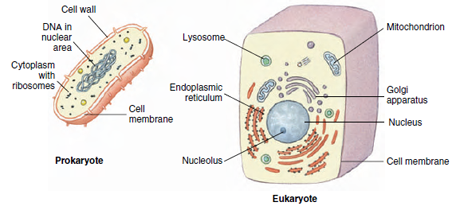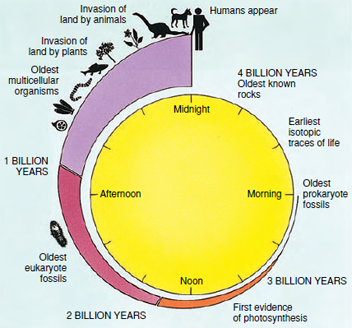Appearance of the Eukaryotes
Appearance of the
Eukaryotes
The eukaryotes (“true nucleus”; Figure
2-15) have cells with membranebound
nuclei containing chromosomes
composed of chromatin.
Constituents of eukaryotic chromatin
include proteins called histones and
RNA, in addition to the DNA. Some
nonhistone proteins are found associated
with both prokaryotic DNA and
eukaryotic chromosomes. Eukaryotes
are generally larger than prokaryotes
and contain much more DNA. Cellular
division usually is by some form of
mitosis. Within their cells are numerous
membranous organelles, including
mitochondria, in which the enzymes
for oxidative metabolism are packaged.
Eukaryotes include animals,
fungi, plants, and numerous singlecelled
forms formerly known as “protozoans”
or “protists.” Fossil evidence
suggests that single-celled eukaryotes
arose at least 1.5 million years ago
(Figure 2-16).
Molecular sequencing has emerged as a very successful approach to unraveling the genealogies of ancient forms of life.The sequences of nucleotides in the DNA of an organism’s genes are a record of evolutionary relationship, because every gene that exists today is an evolved copy of a gene that existed millions, even billions, of years ago. Genes become altered by mutations through the course of time, but vestiges of the original gene usually persist.With modern techniques, one can determine the sequence of nucleotides in an entire molecule of DNA or in short segments of the molecule.When corresponding genes are compared between two different organisms, the extent to which the genes differ can be correlated with the time elapsed since the two organisms diverged from a common ancestor. Similar comparisons can be made with RNA and proteins.
Because the organizational complexity
of the eukaryotes is much
greater than that of the prokaryotes, it
is difficult to visualize how a eukaryote
could have arisen from any known
prokaryote. The American biologist
Lynn Margulis and others have proposed
that eukaryotes did not in fact
arise from any single prokaryote but
were derived from a symbiosis (“life
together”) of two or more types of bacteria.
Mitochondria and plastids, for
example, each contain their own complement
of DNA (apart from the nucleus
of the cell), which has some
prokaryotic characteristics.
Nuclei, plastids, and mitochondria each contain genes encoding ribosomal RNA. Comparisons of the sequence of bases of these genes show that the nuclear, plastid, and mitochondrial DNAs represent distinct evolutionary lineages. Plastid and mitochondrial DNAs are closer in their evolutionary history to bacterial DNAs than to the eukaryotic nuclear DNA. Plastids are closest evolutionarily to cyanobacteria, and mitochondria are closest to another group of bacteria (purple bacteria), consistent with the symbiotic hypothesis of eukaryotic origins. Mitochondria contain the enzymes of oxidative metabolism, and plastids (a plastid with chlorophyll is a chloroplast) conduct photosynthesis. It is easy to see how a host cell that was able to accommodate such guests in its cytoplasm would have had enormous evolutionary success.
In addition to maintaining that mitochondria and plastids originated as bacterial symbionts, Lynn Margulis argues that eukaryote flagella, cilia (locomotory structures), and even the spindle of mitosis came from a kind of bacterium like a spirochete. Indeed, she suggests that this association (the spirochete with its new host cell) made the evolution of mitosis possible. Margulis’s evidence that the organelles are former partners of the ancestral cell is now accepted by most biologists.
Eukaryotes may have originated more than once. The first eukaryotes were undoubtedly unicellular, and many were photosynthetic autotrophs. Some of these forms lost their photosynthetic ability and became heterotrophs, feeding on the autotrophs and the prokaryotes. As the cyanobacteria were cropped, their dense filamentous mats began to thin, providing space for other organisms. Carnivores appeared and fed on herbivores. Soon a balanced ecosystem of carnivores, herbivores, and primary producers appeared. By freeing space, cropping herbivores encouraged a greater diversity of producers, which in turn promoted the evolution of new and more specialized croppers. An ecological pyramid developed with carnivores at the top of the food chain.
The burst of evolutionary activity that followed at the end of the Precambrian period and beginning of the Cambrian period was unprecedented. Some investigators hypothesize that the explanation for the “Cambrian explosion” lies in the accumulation of oxygen in the atmosphere to a critical threshold level. Larger, multicellular animals required the increased efficiency of oxidative metabolism; these pathways could not be supported under conditions of limiting oxygen concentration.
 |
| Figure 2-15 Comparison of prokaryotic and eukaryotic
cells. Prokaryotic cells are about one-tenth the size of eukaryotic cells. |
Molecular sequencing has emerged as a very successful approach to unraveling the genealogies of ancient forms of life.The sequences of nucleotides in the DNA of an organism’s genes are a record of evolutionary relationship, because every gene that exists today is an evolved copy of a gene that existed millions, even billions, of years ago. Genes become altered by mutations through the course of time, but vestiges of the original gene usually persist.With modern techniques, one can determine the sequence of nucleotides in an entire molecule of DNA or in short segments of the molecule.When corresponding genes are compared between two different organisms, the extent to which the genes differ can be correlated with the time elapsed since the two organisms diverged from a common ancestor. Similar comparisons can be made with RNA and proteins.
 |
| Figure 2-16 The clock of biological time. A billion seconds ago it was 1961, and most students using this text had not yet been born. A billion minutes ago the Roman empire was at its zenith. A billion hours ago Neanderthals were alive. A billion days ago the first bipedal hominids walked the earth. A billion months ago the dinosaurs were at the climax of their radiation. A billion years ago no creature had ever walked on the surface of the earth. |
Nuclei, plastids, and mitochondria each contain genes encoding ribosomal RNA. Comparisons of the sequence of bases of these genes show that the nuclear, plastid, and mitochondrial DNAs represent distinct evolutionary lineages. Plastid and mitochondrial DNAs are closer in their evolutionary history to bacterial DNAs than to the eukaryotic nuclear DNA. Plastids are closest evolutionarily to cyanobacteria, and mitochondria are closest to another group of bacteria (purple bacteria), consistent with the symbiotic hypothesis of eukaryotic origins. Mitochondria contain the enzymes of oxidative metabolism, and plastids (a plastid with chlorophyll is a chloroplast) conduct photosynthesis. It is easy to see how a host cell that was able to accommodate such guests in its cytoplasm would have had enormous evolutionary success.
In addition to maintaining that mitochondria and plastids originated as bacterial symbionts, Lynn Margulis argues that eukaryote flagella, cilia (locomotory structures), and even the spindle of mitosis came from a kind of bacterium like a spirochete. Indeed, she suggests that this association (the spirochete with its new host cell) made the evolution of mitosis possible. Margulis’s evidence that the organelles are former partners of the ancestral cell is now accepted by most biologists.
Eukaryotes may have originated more than once. The first eukaryotes were undoubtedly unicellular, and many were photosynthetic autotrophs. Some of these forms lost their photosynthetic ability and became heterotrophs, feeding on the autotrophs and the prokaryotes. As the cyanobacteria were cropped, their dense filamentous mats began to thin, providing space for other organisms. Carnivores appeared and fed on herbivores. Soon a balanced ecosystem of carnivores, herbivores, and primary producers appeared. By freeing space, cropping herbivores encouraged a greater diversity of producers, which in turn promoted the evolution of new and more specialized croppers. An ecological pyramid developed with carnivores at the top of the food chain.
The burst of evolutionary activity that followed at the end of the Precambrian period and beginning of the Cambrian period was unprecedented. Some investigators hypothesize that the explanation for the “Cambrian explosion” lies in the accumulation of oxygen in the atmosphere to a critical threshold level. Larger, multicellular animals required the increased efficiency of oxidative metabolism; these pathways could not be supported under conditions of limiting oxygen concentration.




